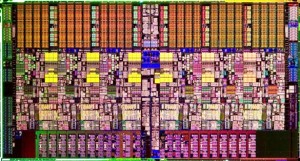September 6th, 2012 ~ by admin
A Brief History
Long before the mess of Apple vs. Samsung (and seemingly everyone else), there was another famous company, with a patent in hand, that it seemed everyone was violating. The issue of Intellectual Property (IP), and its associated patents has long been an issue in the technology business, and certainly in the business of CPU’s. There are many many functions inside a CPU, different structures for handling instructions, memory access, cache algorithms, branch prediction etc. All of these are unique, intellectual property. It doesn’t matter if you implement them with a slightly different transistor structure, as long as the end product is relatively the same, there is the risk of violating a patent. Patents are tricky things, and litigating them can be very risky. You must balance the desire to keep competition from violating your IP, but at the same time minimize the risk that your patent is declared invalid. This is why most cases end up in an out of court settlement, usually via arbitration. Actual patent jury trials are fairly rare, as they are very expensive and very risky to all parties involved

Infringing?
In the early days (1970’s and early 1980’s) there was routine and widespread cross licensing in the industry. Many companies didn’t have the fab capacity to reliably meet demand (IBM wouldn’t purchase a device unless it was made by at least 2 companies for this very reason) so they would contract with other manufacturers to make their design. Having other companies manufacture your design, or compatible parts, also increased the market share of your architecture (8086, 68k etc). For years AMD made and licensed most everything Intel made, AMD also licensed various peripheral chips to Intel (notably the 9511/2 FPU). As the market grew larger, the competition increased, Intel (and others) began to have enough reliable fab capacity to safely single source devices. Meanwhile other companies continued to make compatible products, based on previous licensing. AMD notably made x86 CPU’s that ate into Intel’s market share. In the 1970’s Intel had cross license agreements with AMD, IBM, National, Texas Instruments, Mostek, Siemens, NEC and many others.
Read More »
May 9th, 2011 ~ by admin

Traditional microprocessor transistors are "planar" or flat as they pass through the switching gate
April marked the 50th anniversary of Robert Noyce’s patent on making silicon IC’s with a planar process, a concept that has changed little since then. That is, until this month, when Intel announced their new 22nm process, a process that will not be restricted to planar transistors. Intel, like Hollywood as of late, has gone 3D, Instead of a transistor being built in planes (layers) Intel has developed a way to produce transistors with source/drain spanning several planes on the die, essentially they are formed vertically, rather then horizontally.
This in an of itself is not remarkable, it has been thought of, and done before. What Intel did is make it happen on a commercially viable process. Intel claims to be able to initially manufacture these on a commercial scale at only a 3% cost increase over traditional planar processes, and of course expects that 3% added cost to drop to zero, or in fact result in a cost savings, as the process is refined.

The Tri-Gate system features 3D "fins". This allows the same surface area, in a smaller die area.
What this allows is 2-3 times the number of transistors in the same space as a planar process (assuming the same process size). Intel plans to use this process for the 22nm node. Intel’s first processor, the 4004, was constructed on a 10 micron process with 2300 transistors. Thats 500,000 times larger features and over a million times less transistors, yet it consumed almost a 1 watt of power. With Intel’s new 3-D 22nm process it should give Intel the break they need into the mobile phone market, a market they have been desiring to reenter ever since selling off their mobile ARM (PXA//StrongARM) division to Marvell several years ago.
March 16th, 2010 ~ by admin
Earlier we talked about why old designs are not going away. Today lets look at a new design. The Intel Corei7-980X Extreme. Currently one of the most powerful processors in existence. For comparisons sake I am going to loosely compare the 980X to the Motorola 68000 which arguably was the first 32 bit CPU. (yes the 980x is technically 64 bit but for the sake of comparison we’ll use it).
|
Core i7 980X |
Motorola MC68000 |
| Speed |
3600MHz |
4MHz |
| Transistors |
1.17 Billion |
40,000 |
| Process |
0.032 micron |
3.5 micron |
| Power |
130W |
1.35W |
| Voltage |
0.95V |
5V |
| Cost |
$999 |
~$30 |
Too put that in perspective you could stick over 29,000 MC68K cores on a 980X die.

Intel Core i7-980X Processor die
So while old designs are still in wide use (and will continue to be) the new processors are nothing short of amazing.
980G Review may be found here at Hot Hardware
January 19th, 2009 ~ by admin
In 2002 Intel released a new dedicated I/O processor called the 80303, part of the IOP3xx series. It was meant to replace the i960RN series for use in RAID controllers etc, and runs at 100MHz. As far as I can tell the 80303 is an enhancement of the i960 procecessor, it was quickly replaced by a XScale series device (IOP8034X) This particular one was found on the main board of a Dell PowerEdge 2600 dual Xeon server.
Update: I found a datasheet for this, its core is an i960JT running at 100MHz

Intel IOP303 Processor.






